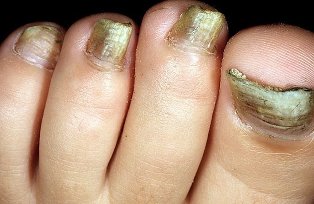Many are not even aware that the banal sweating of the feet, accompanied with a unpleasant smell, from which suffer more than half of the population of our planet is one of the main symptoms of nail fungus. The disease runs the risk of Contracting any gamer who neglects personal hygiene. Nail fungus lurks everywhere, especially in public areas. And the worst thing is that the nail fungus — quite an insidious disease: its treatment is long and not always successful, such as athlete's foot are more likely to relapse. In order to identify the disease and begin treatment, you will need to know that not all signs of fungus on the feet.

The spread of the disease?
The infection caused a parasitic fungus. The ideal environment for their breeding and development (high humidity, combined with a warm atmosphere. It is considered that the main areas where a high risk of Contracting nail fungus, it is a spas, saunas, steam rooms, water parks, swimming pools, nail salons, etc. the statistics, However, completely disproves these tags: nail fungus, you can pick up at home with some common goods (towels, shoes, garments, mattress, shower, or tub), or if one of the members of the family have already had this problem, or is a party, for example, through the Slippers, kindly provided by the host (and he may not even suspect the existence of disease).
But, what are the factors that affect the development of fungus diseases? Celebrate those important moments that led up to the infection. onychomycosis:
- to reduce the immune system;
- an injury to the nail plate;
- poor circulation in the lower extremities that can occur when you wear tight shoes;
- foot pathology anatomical in nature;
- thickness;
- diabetes mellitus;
- the excessive perspiration.
To at least partially protect yourself, you should use it only for their own affairs, to be carefully treated with antiseptics, bath and shower, use of a personal towel, regular cleaning and laundering of carpets, disinfect the shoes. And let's not miss the positive for a treatment of a mycosis, a moment (after all, everyone knows that the therapy is most effective in the initial stages of the disease), we need to know the first signs of nail fungus on your feet.
How to recognize onychomycosis?
The signs of nail fungus at different stages of development can be distinguished from each other, indicating that the progression of the infection. For example, the early stages, no symptoms are practically absent. The nail plate you can see the barely visible whitish spots or lines. These symptoms should be a cause for concern, as they are able to speak in the presence of a fungal infection. If you ignore the first symptoms, there is a risk that you start the fungus, which will affect a healthy nail, and it will lead to the appearance of pus in the periungual tissue, and this can lead to gangrene and amputation of the lower limbs.
On the second level of fungal nail disease that is manifested by the lack of a natural Glow to the nail plate. In addition, a change in nail colour, it appears yellow, white, and brown stripes. You can deform the upper part of the nail, and the side surfaces. These features are clearly visible in the photo.
The advanced stage of onychomycosis, characterized by brittleness, and delamination of the nail plate, inflammation of the cuticle. There is a risk of damage to your nails. But the unpleasant fact is that the disease continues to spread to other nails of the lower limbs and the skin of the feet. The treatment in this case, you need to get started right away in order to avoid the unpleasant consequences of the disease.

The second and third phase of the onychomycosis, the patient is able to recognize himself: the nail gets yellow or a dirty brown colour, and becomes of a loose and thick behind from the nail bed, it becomes very fragile and brittle. Sometimes wearing a closed Shoe it gets painful and itchy on the skin — unbearable (this symptom is especially enhanced in the increased sweating). In addition to this, the reason for the question of onychomycosis can be of the following additional symptoms occur on the skin close to the nails:
- burning;
- intolerable itching;
- flaking and dryness;
- inflammation;
- weeping lesions;
- a thickening and cornification.
The recognition of the early signs of nail fungus, you should immediately consult with a specialist who will prescribe the best treatment regimen.
What impact will they have a variety of different types of onychomycosis?
Define the 3 types of onychomycosis, each of which manifests its own characteristics.
- Normotroficheskie nail fungus is characterized by discoloration of the nail plate the other nails, you can take the colours from white to dark green. In the first stage of the disease, the nail may appear white round spots and longitudinal. As the disease progresses the shadow of the nail can be different, and the fungus spreads to the entire area of the nail plate. However, its thickness does not change, and the natural Sheen is maintained.
- Hypertrophic nail fungus is accompanied by a change in the color of the nail plate, loss of luster of the surface, the strong thickening and deformity. The toe nails strongly exfoliate, begin their part of the destruction.
- Atrophic fungus is characterized by a change in nail color with its subsequent cleaning. The result of this is a fungal infection, is a rejection of the patient's nail, or the infected area.
In order to determine the presence of the fungus, the nail may be yourself, however, to establish a correct diagnosis can only by a specialist. For this you will need to visit the clinic in order to take the analysis to the patient scraping of the nail or on the skin, that is about it. In addition, a dermatologist appoint microscopic examination.
The signs of a fungus pathogen of the disease
A successful treatment for your nail fungus depends on how it needs to be diagnosed. the causative agent of the disease. The reason for this is that the disease causes by a fungus species, but more than that, and every single one of them are very sensitive to certain drugs. That is, if one of a number of fungi that are resistant to a single drug, a pathogen, it means death.

Often a nail fungus for the reason:
- yeast;
- dermatophytes;
- there.
If the underlying cause of nail fungus yeast has begun to identify the disease, all of a sudden is almost impossible. Signs of the fungus on the toe nails, in this case, are as follows (they can also occur after a long period of time): peel of the nail plate, and the light scratching of the skin around the nail (for scratching, it may be omitted). An infection of nail yeast to be found in 4-4,5% of the cases.
Dermatophytes impress nails, a lot more than the previous one pathogen was 94.5% of all cases of infection of the nails by a fungus. Dermatophytes are of three kinds, infecting each of which is expressed in a variety of ways:
- The first type is characterized by complex lesions of the feet, the feet and the nails. The fungus can be easily spread on the skin, and the nails of the hands.
- The second type affects only the little finger nail or the big toe. It can be spread in the interdigital folds, and the fingers, and some of the.
- The third type is characterized by the loss of the nails of the thumb and the little finger, but the skin of the fungus is not affected.
The second type of fungus — mold. Its pathogen — a fungus. The disease is found only in 1% of cases. It develops a fungus of this kind are more likely in HIV-infected individuals.
Other symptoms of a fungal infection of the nails
Often, at the beginning of the disease, obvious signs of a fungal nail does not exist. However, if you are attentive, you will notice a lot of changes in the structure of nails and their appearance. As mentioned previously, the nail plate may appear in controls, or round whitish spots, the nail may become crooked, while its smoothness and Luster to be lost. Progressing, the disease, the more it damages your nail plate: first of all, to the changes of its shadow, and then the surface of the nail becomes scaly, it is thick, or is thin, peeling, breaking. The color of the nail depends on the type of fungus became a pathogen.
In addition to the basic features of onychomycosis, there are other

- the instability of the edges of the nail plate, or the whole of its surface;
- the distortion of the shapes of the nail, changing its structure;
- the blackening of the nails.
- the cutting of the nails under the skin;
- dysbiosis, drowsiness, weakness;
- the detachment of the plate from the nail bed, which leads to the formation of the board under the nails whitish or yellow color, with an unpleasant odor;
- itching, cracking, burning of the skin, in the immediate vicinity of the affected nail;
- dysbiosis, drowsiness, General weakness.
Any deviation in the appearance of the nails need to be kept informed, as this may be indicative of the development of nail fungus. The first action in this case — a visit to a dermatologist, who will confirm or deny your fears. If this is not done promptly, the disease will progress. At first glance, nothing in this disease, it is not. However, in addition to the purely aesthetic problems and a nuisance, a fungus, can cause serious complications, up to a purulent infection of the affected areas, and even the development of gangrene. We therefore do not tighten with treatment, is taking action, immediately, as the disease is discovered.





























